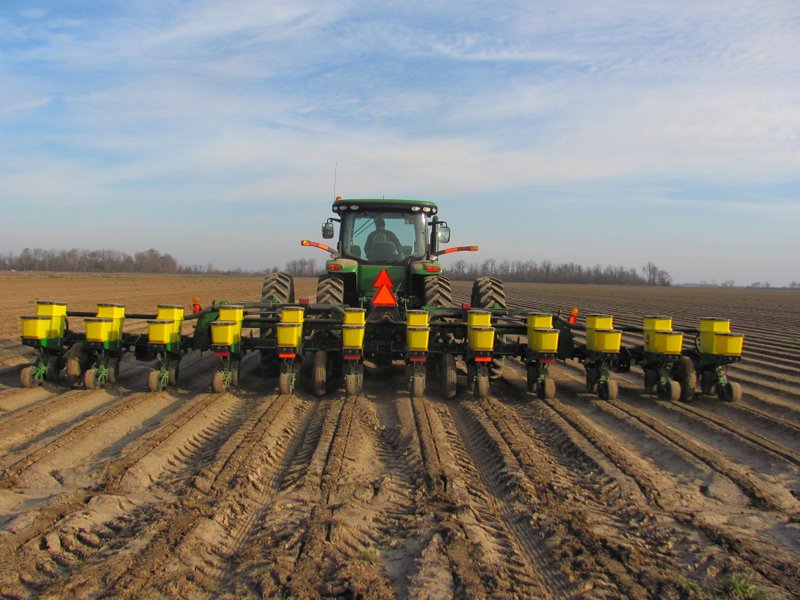LITTLE ROCK — For the first time since 1940, Arkansas farmers will plant more corn acres than cotton.
Arkansas farmers intend to plant 660,000 acres of corn this year, a 17 percent increase from last year when farmers planted 560,000 acres, the U.S. Department of Agriculture said Friday. Cotton is expected to fall about 13 percent, to 590,000 acres, from 680,000 acres planted last year.
“It’s a historic moment in terms of acreage shifts in the state,” said Scott Stiles, extension economist for the University of Arkansas Division of Agriculture. “Today’s corn acreage estimate will be the highest planted in Arkansas since 1956.”
He said higher demand for corn, in part because of its use in making ethanol to blend with gasoline, is driving its price up and making it more attractive to farmers. He noted that cotton prices were at historic lows this year and said cotton yields can vary so much that corn is less risky.
Steve Stevens, who farms in Desha County outside Dumas, said he’s planting more corn than last year because of prices and yields, and because it’s a good rotation crop. He said he is planting about 1,100 acres of cotton and about that much corn along with 2,500 acres of soybeans. Last year, he planted 1,800 acres of cotton and 600 acres of corn.
“We dropped cotton acres about 30 percent this year,” he said in a phone interview Friday. “Yields have been so much of a yo-yo ... we’ve been going to corn because it has a more steady yield. We converted the fields that were the shortest cotton yields last year and moved them to corn.”
At the same time, rice acres are expected to be the fewest since 1989. Arkansas grows more rice than any other state.
The USDA predicted that Arkansas rice farmers will plant 1.16 million acres, down 3 percent from 2011 when farmers planted 1.19 million acres.
Stiles said he was surprised that rice acres aren’t even fewer considering the better price for soybeans. He said that whenever you have “competing crops,” the one with the better price is usually chosen by farmers.
“Total rice acres came in a little higher than expectations,” Stiles said.
According to Stiles, the drop is “entirely” because of a 60 percent cut in mediumgrain acres, from 255,000 to 100,000. Long-grain acres are projected to increase from 940,000 to 1.06 million.
Soybean acres are projected to fall by nearly 1 percent to 3.30 million this year, down from 3.33 million.
The USDA report stated that 95.9 million acres of corn are expected to be planted this spring. That would be 4 percent higher than a year ago and the highest since 1937, when 97.2 million acres were planted.
Stiles said that in the 1940s, farmers needed more corn to feed livestock, such as mules, that were used to work the farms. He said that after World War II less corn was needed as farmers bought tractors and planters.
Since then, cotton acreage has slowly fallen as farmers were able to get higher yields per acre.
“You can get the same yield today on 680,000 acres of cotton as you could from 2.5 million acres in the 1940s,” Stiles said.
Also, countries such as India and China are growing more cotton than in the past, he said.
In addition, corn is also more resistant to pigweed and insects, a concern for farmers this year because of a mild winter.
Charles Dalton, a meteorologist with the National Weather Service in North Little Rock, said that if March ended Friday, it would be the hottest on record, “by a few percentage points.”
Unlike last year, drought is less of a problem for farmers this year, with no area of the state experiencing any drought conditions, the U.S. Drought Monitor said Tuesday.
The warm weather should improve the corn yield, Stiles said.
“Getting an early start like this is always a prescription for higher yields,” he said. “We could have record corn yields and, likely, good rice yields, too.”
Rick Bransford, a Lonoke County farmer, said Friday that he was planting more corn this year than cotton because of higher prices and better yields.
“We like to grow cotton,” Bransford said. “It’s what got us here, and I am bit nostalgic for it, but we have to make decisions based on prices, too.”
Business, Pages 28 on 03/31/2012
